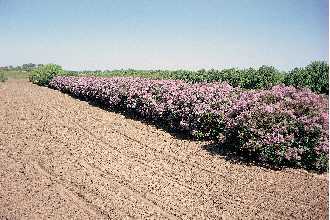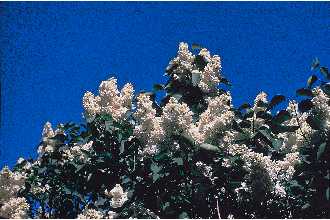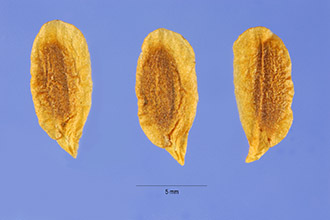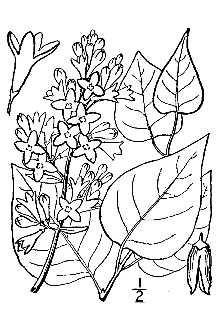Common Lilac
Scientific Name: Syringa vulgaris L.
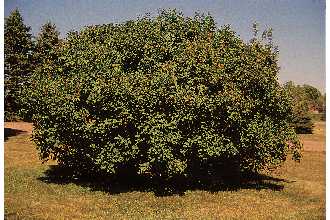
| General Information | |
|---|---|
| Usda Symbol | SYVU |
| Group | Dicot |
| Life Cycle | Perennial |
| Growth Habits | Shrub |
| Native Locations | SYVU |
Plant Guide
Alternative Name
common lilac
Uses
Economic: A green dye is obtained from the flowers and the leaves and a yellow-orange dye is obtained from the twigs (Grae 1974). An essential oil is obtained from the flowers and used in perfume fragrances. Ethnobotanic: The bark and leaves has been chewed as a treatment for sore mouth (Moerman 1998).
Status
Please consult the Plants Web site and your State Department of Natural Resources for this plant’s current status, such as, state noxious status and wetland indicator values, Use soil moisture sensors to measure the soil moisture of Common Lilac.,
Description
General: Olive Family (Oleaceae). Lilac is an introduced, perennial, deciduous shrub that grows between twelve to sixteen feet tall. The leaves are simple, ovate to broadly ovate, and five to twelve centimeters long. The flowers are mostly white, lilac, or purple, pleasantly fragrant in long terminal panicles (Copperrider 1995). The fruiting capsules are one to 1.5 centimeters long, with flat winged seeds (Bruggen 1976). Distribution: Common lilac is native of Europe, introduced and naturalized in the United States, escapes from cultivation from New York to North Dakota, south to Georgia and Kansas (Steyermark 1963). For current distribution, please consult the Plant profile page for this species on the PLANTS Web site. Conservation Trees & Shrubs for Montana USDA, NRCS, Montana State Office
Adaptation
Lilac is easily grown on most soil types but prefers neutral to slightly acid soil. This species does not tolerate poorly drained soils. It performs best in a warm sunny position.
Establishment
Propagation by Seed: Lilac seeds should be sown in March, or as soon as they are ripe, in a cold frame. The seeds should be pre-treated for four weeks of warm stratification and then three weeks cold stratification to improve germination. Place the seedlings into individual pots when they are large enough to handle. If sufficient growth is made by the summer it is possible to out-plant otherwise grow seedlings in a cold frame for the first winter and out-plant in late spring the next year.
Management
Common lilac should be planted in areas with good air circulation to reduce problems with powdery mildew. The first year after planting, Syringa vulgaris will probably not produce many, if any blooms; only after it has adapted itself to its new surroundings will it begin to produce flower clusters with vigor. Pruning should be done yearly to maintain desired height and improve form. Cultivars, Improved and Selected Materials (and area of origin) Commonly available through commercial nurseries. Contact your local Natural Resources
Conservation
Service (formerly Soil Conservation Service) office for more information. Look in the phone book under ”United States Government.” The Natural Resources Conservation Service will be listed under the subheading “Department of Agriculture.”
Plant Traits
Growth Requirements
| Temperature, Minimum (°F) | -38 |
|---|---|
| Adapted to Coarse Textured Soils | Yes |
| Adapted to Fine Textured Soils | Yes |
| Adapted to Medium Textured Soils | Yes |
| Anaerobic Tolerance | None |
| CaCO3 Tolerance | High |
| Cold Stratification Required | Yes |
| Drought Tolerance | Medium |
| Fertility Requirement | Medium |
| Fire Tolerance | High |
| Frost Free Days, Minimum | 110 |
| Hedge Tolerance | High |
| Moisture Use | Medium |
| pH, Maximum | 7.8 |
| pH, Minimum | 5.8 |
| Planting Density per Acre, Maxim | 1200 |
| Planting Density per Acre, Minim | 700 |
| Precipitation, Maximum | 50 |
| Precipitation, Minimum | 30 |
| Root Depth, Minimum (inches) | 14 |
| Salinity Tolerance | Medium |
| Shade Tolerance | Intermediate |
Morphology/Physiology
| Bloat | None |
|---|---|
| Toxicity | None |
| Resprout Ability | Yes |
| Shape and Orientation | Erect |
| Active Growth Period | Spring and Summer |
| C:N Ratio | Low |
| Coppice Potential | No |
| Fall Conspicuous | No |
| Fire Resistant | No |
| Flower Color | Purple |
| Flower Conspicuous | Yes |
| Foliage Color | Green |
| Foliage Porosity Summer | Dense |
| Foliage Porosity Winter | Moderate |
| Foliage Texture | Medium |
| Fruit/Seed Conspicuous | No |
| Nitrogen Fixation | None |
| Low Growing Grass | No |
| Lifespan | Moderate |
| Leaf Retention | No |
| Known Allelopath | No |
| Height, Mature (feet) | 20.0 |
| Height at 20 Years, Maximum (fee | 20 |
| Growth Rate | Moderate |
| Growth Form | Rhizomatous |
| Fruit/Seed Color | Brown |
Reproduction
| Vegetative Spread Rate | Moderate |
|---|---|
| Small Grain | No |
| Seedling Vigor | Medium |
| Seed Spread Rate | Slow |
| Fruit/Seed Period End | Summer |
| Seed per Pound | 90720 |
| Propagated by Tubers | No |
| Propagated by Sprigs | No |
| Propagated by Sod | No |
| Propagated by Seed | Yes |
| Propagated by Corm | No |
| Propagated by Container | Yes |
| Propagated by Bulb | No |
| Propagated by Bare Root | Yes |
| Fruit/Seed Persistence | Yes |
| Fruit/Seed Period Begin | Summer |
| Fruit/Seed Abundance | Medium |
| Commercial Availability | Routinely Available |
| Bloom Period | Late Spring |
| Propagated by Cuttings | No |
Suitability/Use
| Veneer Product | No |
|---|---|
| Pulpwood Product | No |
| Protein Potential | Low |
| Post Product | No |
| Palatable Human | No |
| Palatable Graze Animal | Low |
| Palatable Browse Animal | Low |
| Nursery Stock Product | Yes |
| Naval Store Product | No |
| Lumber Product | No |
| Fodder Product | No |
| Christmas Tree Product | No |
| Berry/Nut/Seed Product | No |

